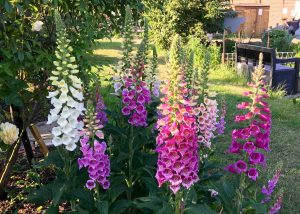
June Foxgloves
Maintaining soil structures and planning ahead
- Continue to hand-weed or hoe regularly to keep on top of weeds.
- Dig deep to remove highly invasive bind weed as it appears.
- Continue to mow or clip grass paths weekly.
- If you have sown green manure, dig it in this month to fix the nitrogen in the soil.
- In the greenhouse ensure adequate shading. Check night time temperatures and close door on cold nights. On hot days keep greenhouse temperatures down by using maximum ventilation and damp down greenhouse floors to increase humidity.
- Use insect-proof mesh over carrots to prevent carrot fly attacking carrots. Ensure it is well-pegged down, not leaving any gaps.
- Use insect-proof mesh over leeks to prevent leek moth damaging leeks. Ensure it is well-pegged down, not leaving any gaps.
Sowing and Growing
- Direct-sow courgettes.
- Sow radicchio in drills for autumn salad leaves.
- Sow fennel and oriental greens such as mizuna and pak choi. June sowings reduce the risk of bolting.
- Successionally sow salads, rocket and basil etc every two to three weeks for continuous picking.
- Make a late sowing of peas for an autumn crop.
- Sow overwintering carrots such as Autumn King or Chantenay.
- Quick-maturing radishes or salad leaf crops can be sown between brassica rows.
- Quick-germinating annuals, such
as cosmos, that attract insect pollinators can still be sown.
Sow wallflowers for next year. - Water potatoes well for good-sized tubers and reduced problems with scab. (Remember to target-water, not spray, to avoid water wastage.)
- Water tomatoes regularly and
evenly. Uneven watering can cause cracked fruit and blossom end rot.
Regularly pinch outside shoots on cordon tomatoes and tie in plants
to supports.
Feed every 10-14 days with a liquid fertilizer, changing to a high potash fertilizer once the first fruits begin to set. - Plant out sweet corn 16” apart in blocks, not rows, to aid wind pollination.
- Continue planting out or direct-sow runner and French beans.
- Transplant pencil-thick leeks now into 6” deep holes.
- Plant out pumpkins, squashes in well manured ground. Plant out outdoor cucumbers and peppers. Protect with fleece on cold nights.
- Keep fruit bushes well-watered. (Target-water, not spray, to avoid water wastage.) Protect soft fruit from bird attack by netting securely and tie in new raspberry and blackberry canes.
- Continue to check for sawfly larvae on gooseberries. Hand pick off.
- Remove strawberry runners during the early part of summer, to avoid energy being diverted from the developing fruit.
- On plum trees, after the ‘June drop’ of excess developing fruits, thin the fruits to prevent overladen branches breaking.
Harvesting
- Continue to regularly harvest established asparagus – mid April to mid June. If asparagus growth is weak, apply a general fertilizer of fish, blood and bone.
- First, second and salad potatoes may be ready for harvesting. Tubers should be ready when plants begin to flower.
- Harvest broad beans from the bottom of the plant up. Once the plant is harvested, cut off the stems and dig the roots back into the soil to make use of the captured nitrogen.
- Harvest early peas. Put unused pea pods and foliage into the compost heap or dig into the soil to provide nitrogen rich nutrients to the soil.
Gardening for Wildlife
- If broad beans are affected by blackfly, rub off or spray with a jet of water to remove them rather than using insecticides.
- Create a cool, damp spot for amphibians and their prey to take shelter in by building a log pile in a shady corner. Half bury the bottom logs and fill nooks and crannies with leaves.
- Add a bee house to your plot or garden, placing it in a south-facing spot but not in direct sunlight.
- Select single forms of annual flowers as these provide more pollen for bees. Integrate annual flowers into the vegetable beds to attract beneficial insects such as bees and hoverflies.
- Reduce the use of herbicides, fungicides and insecticides if possible.
